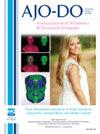Treatment acceptance in adult patients with anterior open bite: A National Dental Practice-Based Research Network study
IF 2.7
2区 医学
Q1 DENTISTRY, ORAL SURGERY & MEDICINE
American Journal of Orthodontics and Dentofacial Orthopedics
Pub Date : 2024-10-01
DOI:10.1016/j.ajodo.2024.06.007
引用次数: 0
Abstract
Introduction
Orthodontists have many techniques to treat anterior open bites and must involve patients in making treatment decisions. This study aimed to investigate orthodontic treatment plan acceptance by United States adults with anterior open bites and to identify associations between treatment acceptance and patient demographics and dentofacial characteristics.
Methods
A prospective, observational cohort study enrolled the patients of 91 orthodontic providers. A total of 345 adults were included in the sample. Provider personal and practice demographics were captured. Patient demographics, treatment goals, dentofacial characteristics, and reasons for not accepting the recommended plans were recorded. Adjusted regression models were used to identify associations between patient characteristics and the likelihood of accepting the most highly recommended plan.
Results
Approximately 78% of patients accepted the most highly recommended treatment plan. 60% of the patients who were recommended surgical plans accepted them. Patients with a history of orthodontics and a concave profile were more likely to accept the most highly recommended plan. Insurance coverage for orthognathic surgery was associated with a higher acceptance rate for surgery. Severe crowding was associated with a lower acceptance of surgery. The most common reasons for declining the recommended plan were not wanting jaw surgery and considering the treatment to be too invasive, risky, and/or costly.
Conclusions
Patient acceptance is less common at higher levels of invasiveness of treatment. Prior orthodontic treatment, concave profile, and insurance coverage for surgery were associated with accepting treatment. Most patients accepted a surgical plan when it was the most recommended option.
前牙开合咬合成年患者的治疗接受度:一项基于国家牙科实践研究网络的研究。
简介:正畸医生有许多治疗前牙开合咬合的技术,必须让患者参与治疗决策。本研究旨在调查美国成年人前牙开合咬合患者对正畸治疗方案的接受程度,并确定治疗接受程度与患者人口统计学和颌面部特征之间的关联:一项前瞻性、观察性队列研究招募了 91 家正畸医疗机构的患者。共有 345 名成年人被纳入样本。研究人员采集了提供者的个人和诊所人口统计数据。记录了患者的人口统计学特征、治疗目标、牙面特征以及不接受推荐方案的原因。使用调整回归模型来确定患者特征与接受最推荐方案的可能性之间的关联:结果:约 78% 的患者接受了最强烈推荐的治疗方案。60%的患者接受了推荐的手术方案。有正畸史和凹面轮廓的患者更有可能接受最强烈推荐的方案。正颌外科手术的保险范围与较高的手术接受率有关。严重拥挤与接受手术的比例较低有关。拒绝接受推荐方案的最常见原因是不想做颌骨手术,以及认为治疗创伤太大、风险太高和/或费用太高:结论:患者接受侵入性较高的治疗的比例较低。之前的正畸治疗、凹面轮廓和手术保险与接受治疗有关。当手术方案是最推荐的选择时,大多数患者都会接受。
本文章由计算机程序翻译,如有差异,请以英文原文为准。
求助全文
约1分钟内获得全文
求助全文
来源期刊
CiteScore
4.80
自引率
13.30%
发文量
432
审稿时长
66 days
期刊介绍:
Published for more than 100 years, the American Journal of Orthodontics and Dentofacial Orthopedics remains the leading orthodontic resource. It is the official publication of the American Association of Orthodontists, its constituent societies, the American Board of Orthodontics, and the College of Diplomates of the American Board of Orthodontics. Each month its readers have access to original peer-reviewed articles that examine all phases of orthodontic treatment. Illustrated throughout, the publication includes tables, color photographs, and statistical data. Coverage includes successful diagnostic procedures, imaging techniques, bracket and archwire materials, extraction and impaction concerns, orthognathic surgery, TMJ disorders, removable appliances, and adult therapy.

 求助内容:
求助内容: 应助结果提醒方式:
应助结果提醒方式:


